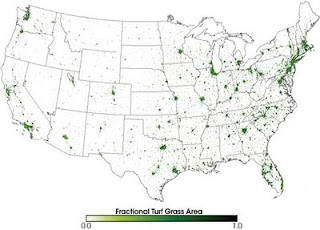
This month's New Yorker has a fascinating article on lawns. The impacts on waterways, ecosystems, and even the climate are huge.
Here's a nice summary of research done by NASA's Cristina Milesi. This is a mind-blower:
“Even conservatively,” Milesi says, “I estimate there are three times more acres of lawns in the U.S. than irrigated corn.” This means lawns—including residential and commercial lawns, golf courses, etc—could be considered the single largest irrigated crop in America in terms of surface area, covering about 128,000 square kilometers in all.
And it seems an awful lot of gasoline is expended on mowing. I don't see how this can be sustainable. What's the contribution to the Gulf's dead zone?
From the New Yorker article:
In “American Green” (2006), Ted Steinberg, a professor of history at Case Western Reserve University, compares the lawn to “a nationwide chemical experiment with homeowners as the guinea pigs.”
And this:
The essential trouble with the American lawn is its estrangement from place: it is not a response to the landscape so much as an idea imposed upon it—all green, all the time, everywhere. Recently, a NASA-funded study, which used satellite data collected by the Department of Defense, determined that, including golf courses, lawns in the United States cover nearly fifty thousand square miles—an area roughly the size of New York State. The same study concluded that most of this New York State-size lawn was growing in places where turfgrass should never have been planted. In order to keep all the lawns in the country well irrigated, the author of the study calculated, it would take an astonishing two hundred gallons of water per person, per day. According to a separate estimate, by the Environmental Protection Agency, nearly a third of all residential water use in the United States currently goes toward landscaping.''
The map is from Malesi's article, and shows fractional area covered by lawns (1.0 = 100%).Labels: conservation, media, New Yorker, sustainability
